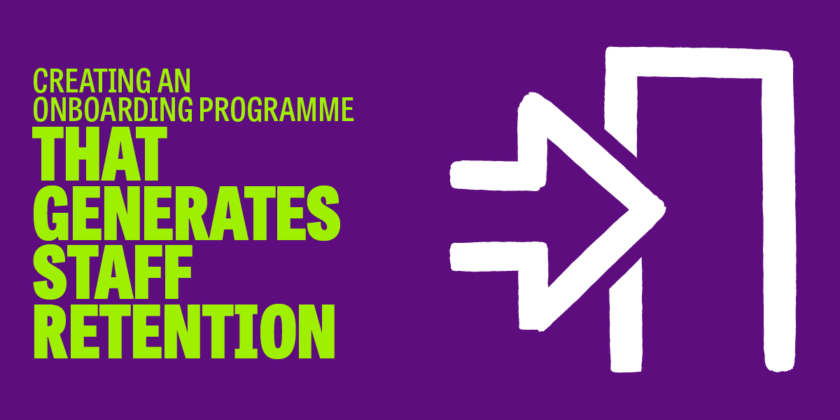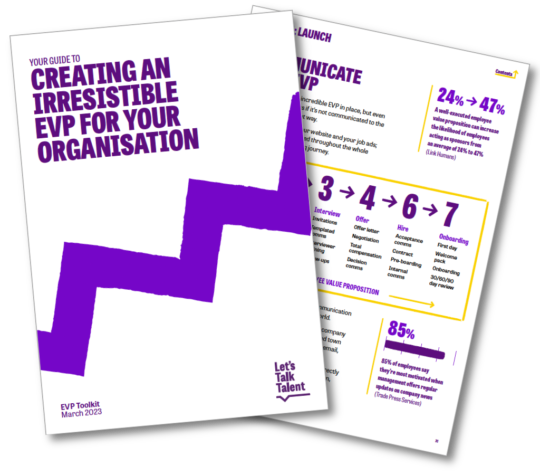Build an onboarding programme that delights your employees
It’s easy for organisations to be too functional and prescriptive in their onboarding programme when it comes to welcoming new talent.
Whether it’s a completely new employee or someone changing their role, it’s likely that you’ll have a whole load of procedures you think are important from day one – a list of things you don’t want new employees to do versus the pressure to get them up and running, integrated, and productive as quickly as possible. A day or so should do it, right?!
If this is your thinking, stop. You’re doing it all wrong.
In this article, we explore the key steps you need to take to make onboarding meaningful for new talent and successful in terms of tangible outcomes.
Setting your onboarding goals
Before you start creating or improving your onboarding experience you need to be clear about what you really want new hires to THINK, FEEL and DO from Day 1 to Day 100 in your business.
By asking yourself the following questions (and taking input from colleagues across your business), you can gain smart insights into where you can improve. For example:
- When a new hire goes home on day one, what do you want them to say to their friends, family or partner?
- Do your new hires need to be keenly aware of the tradition and history of your company or is it more about creativity, innovation and initiative?
- What kinds of experience do you want to create for new hires?
- How will you excite your new hires about the professional and personal journey they are about to take on with you?
- What kind of ROI are you looking for with onboarding and which metrics really matter?
- Which aspects of onboarding will need to be reviewed periodically?
- Do you need to build a uniform process, or should this reflect the different talent tribes across your business?
- What are you going to run centrally and what can be devolved to the team leaders?
- Who owns the onboarding process, you or managers?
- How can valuable insight from within the organisation be used to create something even better?
After you’ve done the necessary soul-searching and know the kind of experience you want to create, it’s time to start building.
You can’t rush this – it’s going to need care and attention to detail in order to successfully engage, embed, and nurture your new talent seedlings. You also need to ensure this is joined up and well thought-out, from the first touchpoint to lasting memory.
Starting before new hires join the organisation
If a new employee is working their notice or even using their final bit of annual leave for some chill time, you can still make them feel cherished. Consider inviting them to have a casual phone call with their new manager or a team member. It’s likely they’ll be feeling excited, nervous and a little vulnerable before starting.
Let them know who their team members are going to be. You can send them some photos, bios, details of their favourite food or even their Twitter and Instagram handles (with their permission, obviously). Send them a postcard, invite them to a social event, ask them to create a playlist on Spotify for their future colleagues. Make it as enjoyable as possible and promote the internal culture of your organisation.
LinkedIn has some great ideas for onboarding, such as a special onboarding toolkit and many companies now have their own app. LinkedIn even has a special hashtag newbies can use, or look at before their first day. It creates the impression of a dynamic working culture that any new person can join. It’s quite beautiful what employees are sharing with the #LinkedInLife tag. It makes you think: “Who wouldn’t want to remain part of their organisation?”
You also need to use your website (ideally with a bespoke portal) to reflect the experience people will have when they start their new role. For example, why not have a virtual office tour, blogs from recently employed team members, or video content from well-established colleagues? It’s all about bringing people up to speed and inspiring them before their first day.
Personalising your onboarding approach
Although you need to expect that people will leave your organisation and that you’re hiring staff for a limited duration, it can be very expensive if many of them leave earlier than you had planned.
Replacing someone can cost you between 90% to 200% of their annual salary, depending on their level. Add to that the possible impact on morale and you can see how damaging a bad onboarding experience can be, and how important it is to get it right.
We need to get away from thinking onboarding is just about the first day, or weeks, of the employee lifecycle. Cramming these early hours and days with your own agenda without considering the needs of employees just doesn’t work. And it’s horrible. We’re not living in the age of factory-style working any more.
It’s about respect and understanding things from the perspective of the employee. They are your consumers and deserve to be respected as such. So, ditch your old-school blinkers and start to see the process as one of effective nurture.
Focusing on the first few days
Research indicates that new hires are leaving companies within their first six months at an alarming rate, with a lack of training cited as one of the key factors driving this. In fact, 76% of employees believe training is the most important factor in the first week. And remember the vast majority of new hires (around 85% according to this study) choose to stay or leave within the first six months. Add to this the fact that 4% of new employees leave after having a nightmare first day, and 20% of leavers go within 45 days, your vision of onboarding needs to be about their journey as much as the destination you want them to arrive at.
The first days, weeks, and months really are critical and according to Harvard Business Review, the biggest stumbling block when it comes to new roles failing or succeeding relates to confusion around company culture. Interestingly, they also report that unsuccessful induction rarely relates to lack of skills or experience.
Therefore, if you can overcome any dissonance between employee expectations and how your organisation actually works, then you’ll stand a better chance of success. Not an easy thing to achieve I know, but if it’s the elephant in the room, and you need to look at it.
Experience, not policies
New employees are interested in their experience of working, not policy documents. They want to be treated as individuals – so don’t overwhelm them with 100-page boring documents.
The challenge is to bring them up to speed without inadvertently pushing them back out the door. The point here is that you should make it meaningful. Put them at the centre of your organisational world. Engage both their heart and head. Employ logic and emotion. Get passionate about what your company offers to new talent.
A great example of an onboarding programme
Not too long ago, we worked with the oil and gas company Oiltanking, designing their onboarding experience for first-time employees, secondments, and newly hired expats into their central office in Hamburg. They employ nearly 4,000 people in 25 countries, so it was really important to make the process as personal as possible.
As well as providing the important collateral needed, we carefully surveyed how new hires were doing after thirty days and ninety days. This insight fed back into the whole induction process and helped them keep onboarding as focused on employees as possible.
Perhaps the most important aspect of what we designed was the Buddy Up scheme, which carefully matched new people with seasoned employees. This was very successful and helped to break down the anxiety so commonly experienced by new hires.
This kind of approach can also increase morale and help build unity and trust swiftly. In a world where time-to-productivity is a key metric, it’s also an example of where human values meet financial expectations. After all, people perform better when they feel good about where they are and who they are working with.
The 5Cs of onboarding
At Let’s Talk Talent, we have a foolproof approach to creating a kickass onboarding programme that works. Only five key elements are required: we call them the 5Cs. Using these will mean you’ll always be looking after your new hires and making sure they’ll want to stick around.
They are:
- Care – the Golden Thread of onboarding
- Culture – putting your mission and purpose forward
- Clarification – making sure employees understand their new role
- Connection – building a network quickly
- Compliance – the legal and procedural stuff
You can read more about the 5Cs of onboarding and how they link to your wider Employee Value Proposition (EVP) in our recent article.
Putting employees at the core of your onboarding programme
Reflecting on our own experience with Let’s Talk Talent clients and the fact that world-leading companies rank engagement, retention, and time-to-productivity as the most valuable to their businesses as a whole, it’s almost shocking to hear that many companies still view induction with a production line attitude that just leads to really terrible experiences for new joiners, and to talented people (very understandably) leaving.
It’s often the small things that make the biggest difference, and our experience has consistently shown us the importance of not overthinking the onboarding process.
Make it about people and human feelings as much as you do about understanding process, policy, and the intricacies of the role and remember that it takes time for people to get up to speed. Knowing that also takes the pressure off hiring managers, as induction over a period of weeks or months (as opposed to days, or in some cases, hours) can then be realistically managed.
Loading everything onto the first few days is too overwhelming and highly ineffective plus it’s likely to cause someone to leave or have a bad experience which will form a negative impression that’s hard to shift.
Another thing to bear in mind is that employees are not as focused on salary and status as they once were. We love how Professor Barry Schwartz contextualises this in his book, Why We Work. It certainly confirms many of the things we have seen and continue to see on a daily basis here at Let’s Talk Talent.
If you’d like some help restructuring your onboarding programme to ensure it focuses on people not process, book a call with us or enquire about our Onboarding Audit. We’re also working on a new Ultimate Onboarding Checklist, which will be available soon – register your interest to receive it as soon as it’s released.

